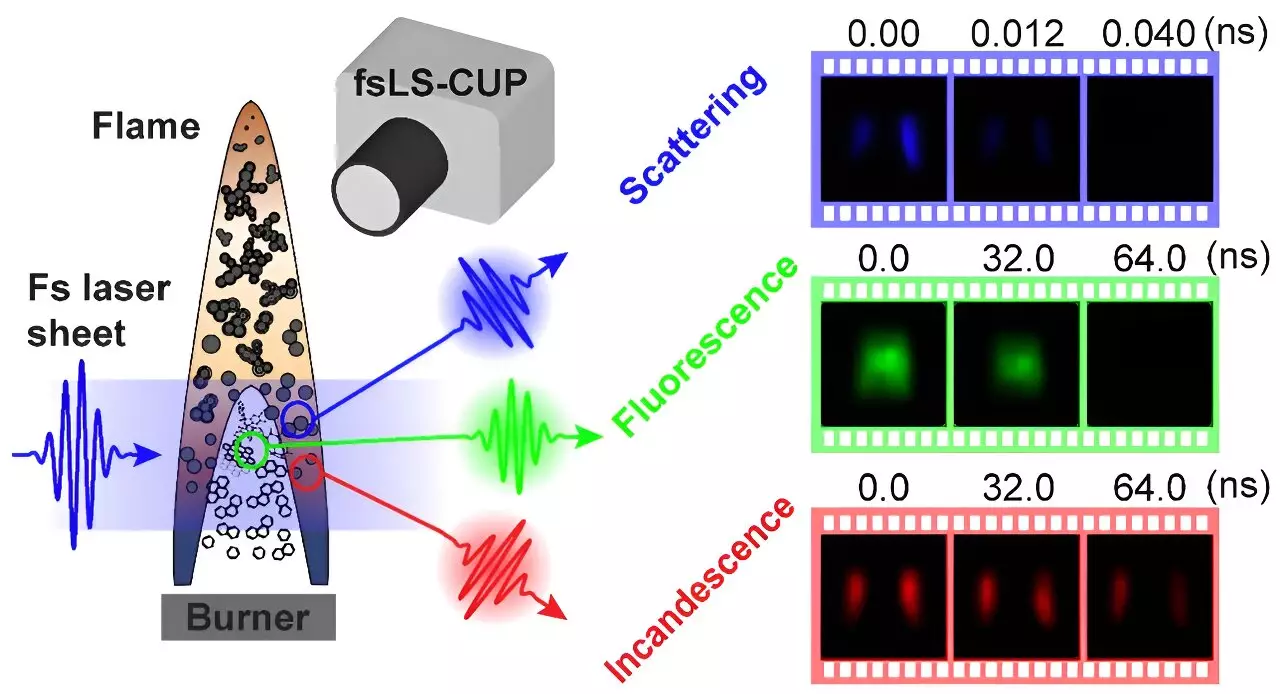The intricate dynamics of soot and polycyclic aromatic hydrocarbons (PAHs) have emerged as a significant area of study due to their implications for both human health and the environment. Soot particles, produced by common sources such as candle flames and airplane engines, are notorious for their harmful effects when released into the atmosphere. Consisting primarily of carbon, these particles contribute to air pollution and climate change. Furthermore, PAHs, organic compounds containing multiple aromatic rings, pose similar threats. Interestingly, these carbon-based entities are not only found in terrestrial environments but also make up a notable percentage—10 to 12%—of interstellar material. As research continues, there is a growing recognition of their utility in advanced technologies, including electronic devices and sustainable energy solutions.
However, the ephemeral nature of soot and PAHs presents a challenge for scientists aiming to study their formation and behavior in real-time. The analytical hurdles arise due to the transience of their signals, which live for mere billionths to millionths of a second under combustion conditions. Capturing such fast phenomena necessitates sophisticated imaging technologies capable of resolving events that occur on these razor-thin timelines.
The existing imaging systems fall significantly short of capturing the rapid dynamics of soot and PAHs. Current setups often can only record a few million frames per second and usually rely on multiple laser pulses, leading to unwanted thermal effects that can distort the results. Traditional methods of capturing combustion events frequently involve sequential image collection, requiring researchers to assemble a motion picture from disparate frames. This approach not only limits the temporal resolution but also intertwines itself with issues of repeatability and accuracy, creating a bottleneck for advancements in combustion science and related fields.
Acknowledging these limitations, researchers have been on the lookout for innovative technologies that can surpass these barriers, enhancing their ability to visualize complex processes like combustion in real-time.
The introduction of femtosecond laser sheet-compressed ultrafast photography (fsLS-CUP) marks a monumental leap in ultrafast imaging technology. This groundbreaking method, developed by a team at the California Institute of Technology, including prominent figures such as Dr. Yogeshwar Nath Mishra and Professor Lihong V. Wang, empowers researchers to capture sequences of events at an exhilarating speed of 250 billion frames per second. This is astonishingly 20,000 times faster than what existing technology can achieve.
By utilizing a single femtosecond laser pulse, fsLS-CUP adeptly captures transient phenomena related to laser-induced fluorescence (LIF) from PAHs, laser-induced heating (LIH) from soot particles, and elastic light scattering from interactions with soot. The capability to obtain full motion images in such short-lived intervals not only augments our fundamental understanding of combustion but also opens innovative avenues for multidisciplinary applications across physics, chemistry, biology, and environmental science.
The outcomes of this research have substantial implications for both scientific inquiry and technological advancements. Dr. Peng Wang articulates the potential of fsLS-CUP to provide insights into rapid natural processes, thereby enhancing our grip on combustion science. The ability to simultaneously observe multiple phenomena through this technique affords researchers a more nuanced understanding of the interplay between PAHs and soot particles in flames.
Moreover, the versatility of fsLS-CUP allows the exploration of phenomena beyond combustion. It equips scientists to probe the intricacies of reactions in various environments, from laboratory settings to astrophysical conditions, expanding our knowledge base regarding carbon compounds in the cosmos. Specifically, Dr. Murthy S. Gudipati’s focus on PAH astrochemistry positions this technique at the forefront of research into the existence and formation of PAHs in extreme astrophysical environments, such as carbon-rich stars.
As fsLS-CUP paves the way for unprecedented imaging capabilities, it establishes itself as a pivotal tool in advancing our understanding of dynamic processes in both terrestrial and extraterrestrial contexts. This development reinforces the importance of innovation and interdisciplinary collaboration, resulting in groundbreaking scientific contributions.
The ongoing evolution of ultrafast imaging technologies signifies a new era in combustion research and related fields, and fsLS-CUP stands at the forefront of this scientific revolution. As we continue to push the envelope of what is possible in imaging, the insights gained from such cutting-edge methodologies will undoubtedly lead to profound advancements in our comprehension of the fundamental processes that shape our world and the universe beyond.


Leave a Reply